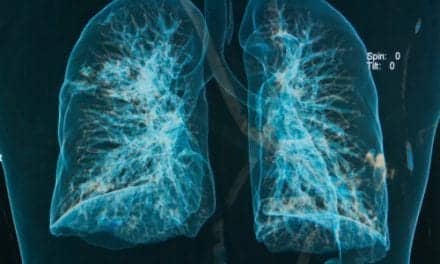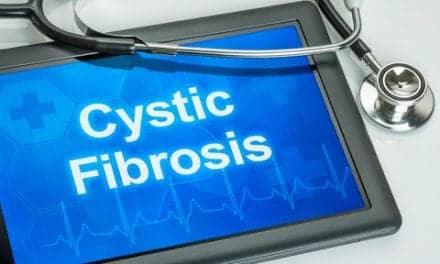Pharmaceuticals used in concert with airway clearance therapy can help cystic fibrosis patients reduce lung infections. Part 1 covered the ways that airway clearance therapy can help cystic fibrosis patients reduce lung infections.
In Part 2, the role of pharmaceuticals in preventing infections in hospitalized patients will be discussed, plus additional info on how ACT technology can be used in cooperation with medications to fight infections. (Part 1 is available here.)
By Phyllis Hanlon
In 2013, the Cystic Fibrosis Foundation (CFF) updated its 2003 guidelines for infection control and prevention in cystic fibrosis,1 emphasizing contact precautions; mask use by patients as well as health care workers; maintaining a minimum six-foot distance between patients; pulmonary function testing to reduce infection risk; and proper disinfection techniques for environmental surfaces. In addition to these recommendations, research has shown that medication, in conjunction with the use of airway clearance devices, can be effective in reducing the risk of infection in patients with CF.

Dabney M. Eidson, BS, RRT, NPS, Pediatric Cystic Fibrosis Center, Augusta University Children’s Hospital of Georgia, said patients with CF are constantly fighting infection. “Patients are in hypermetabolic state and go through a cycle of decreased appetite, vomiting and nausea,” she said, noting that the body needs good nutrition, vitamins and minerals to fight infection. “A majority of CF patients have pancreatic insufficiency so can’t break down vitamins and minerals to create energy.”
When a healthy individual acquires an infection, the body does not harbor that infection the same way that a person with CF does, according to Eidson. “We would take an antibiotic for seven days and finish [the prescription]. The antibiotic is usually potent enough to kill the bacteria. But CF airways have such a propensity for bacteria,” she said and added that research shows if you tackle the infection early, the chances of achieving better lung function in the future increase.
Prior to the release of the updated guidelines from the CFF, gowns and gloves were not always used for every patient with CF, according to Eidson. She explained that staff in her clinic practiced good hand hygiene and always wore gloves when examining a patient or taking a sputum sample. But throughout the week staff might go in and out of several different patient rooms without using contact isolation precautions, while waiting for the results of the culture. “A lot of evidence shows bacteria can survive on surfaces without food source for hours, days or weeks. Even though we were hand washing and gloving, we could still be inadvertently transferring bacteria to other patients,” she said. The recent guidelines encourage staff to assume all patients with CF have an infection. If culture results are positive, the spread of infection can be prevented.
Treatment Options
When a patient with CF develops Pseudomonas aeruginosa, one of the most common infections, the first line therapy is typically oral and inhaled antibiotics, which helps the mucus become less viscous so it will mobilize better and move out of the lungs easier. Eidson noted that more and more studies show that aggressive treatment to eradicate on the first culture will give the patient the opportunity to live longer.
“I have been on the CF team for twelve years and had heard there was a time when we thought having a Pseudomonas aeruginosa infection in the airways was part of having CF,” she said. “We didn’t really treat it when it first showed up, not as aggressively. [Now] if a culture comes back positive, especially with Pseudomonas aeruginosa, we’ll prescribe inhaled tobramycin at 300 mg, twice a day for 28 days. Pseudomonas has been shown to be sensitive to tobramycin,” she said.
If the infection becomes prevalent, then the patient would go on cycle therapy, for example, the patient takes the medication for 28 days and then goes off the medication for 28 days.
Research on aztreonam has also had promising results. Three multinational, multicenter phase II studies demonstrated that “…nebulized 75 mg of aztreonam lysine is a safe and efficient treatment, which can be used repeatedly to suppress the chronic P. aeruginosa lung infection in CF patients.”2
Eidson reported that inhaled amikacin has been considered for treatment of Pseudomonas aeruginosa, but needs more study. “In the spirit of treatment burden, some recommendations say don’t necessarily start amikasin unless you see the mycobacterium is affecting lung health. More study and FDA approval is needed,” she said.
Edith Zemanick, MD, associate professor of pediatrics and associate director of the Pediatric Cystic Fibrosis Center, Children’s Hospital Colorado, indicated that providers are somewhat effective in eradicating P. aeruginosa when the infection is first found in children, but it usually returns. “Eventually 70% of adults have chronic Pseudomonas aeruginosa. We have better treatments than in the past, but still have the problem,” she added.
Other Worrisome Bacteria
Pseudomonas aeruginosa is not the only bacterium that affects the CF population. MRSA, another group of mycobacterium, is not as well researched and studied as P. aeruginosa but can still be problematic. There are currently no official guidelines for treatment but some inhaled antibiotics can be prescribed for MRSA, such as cycle therapy with vancomycin.
However, a 2015 study determined “Vancomycin should only be used as the last line of defense against MRSA infection; this medication must be prescribed only after rationally evaluating its use in individual patients.”3
Zemanick admitted that chronic antibiotic use could be harmful and become less effective. Antimicrobial bacteria can grow and become more resistant with time and exposure to antibiotics. “That being said, with CF the use of antibiotics is hugely beneficial to [patients]. The more aggressive with antibiotics, in general, in treating illnesses early appears to help patient so there is less decline in lung function and better recovery of lung function. We do worry about antimicrobial resistance so [it’s important to] use the appropriate dose.”
The use of antibiotics in CF patients is different than it is in other patient groups. “It has to do with the way bacteria grow in the lungs. We worry, but don’t hesitate to use antibiotics. They benefit patients so much,” Zemanick said.
Some research suggests that Pseudomonas aeruginosa is on the decline. Data from the CFF shows that over last couple of years there has been a slow decrease in P. aeruginosa infections because of more aggressive control and treatment strategies. However, in spite of more intense attempts to control and treat the bacteria, it continues to pose “…a lifelong problem, leading to chronic inflammation and lung tissue damage.”4
Targeting the CFTR Protein
Although several medications have been successful in treating Pseudomonas aeruginosa and other infections in CF patients, the underlying genetic component has not been addressed. Eidson noted that a new class of oral meds is “a key modulator” that works on the cystic fibrosis transmembrane conductance regulator (CFTR) protein. These drugs move back and forth through intracellular areas to bring hydration and thin the mucus, she said. Those oral medications include kalydeco (ivacastor), orkambi (lumacastor-ivacastor) and symdeko (tezacastor). Eidson said, “This modulator class of meds is the first one to address the root problem, but is not a cure.”
Zemanick asserted that it’s important to begin integrating airway clearance at an early age until it becomes habit.5 For younger patients, she recommends airway clearance techniques alone or in conjunction with albuterol. “By age five, patients should start Dornase alfa daily, often with hypertonic saline,” she said. At her clinic, airway clearance standard practice is twice a day; however, if the patient is sick, the frequency is increased to three times a day. She added that the timing can vary, but is generally fifteen to twenty minutes of either CPT or 20 minutes in four and five-minute cycles with huff coughs on the vest.
Zemanick emphasized that patients should not take inhaled antibiotics prior to using an airway clearance device. “You would cough out medications that should be in the lungs,” she said. Also, the order in which medications are taken is important. “You start with albuterol, hypertonic saline, inhaled antibiotic and then a steroid. Patients have to actively participate and be engaged in airway clearance. It’s important to do coughs and clear the chest,” she said.
Medication and Medical Devices
According to Jane E. Gross, MD, PhD, pediatric pulmonologist and assistant professor in pediatrics, National Jewish Health, airway clearance is a vital component in reducing risk of infection in patients with CF. From the initial diagnosis, which often occurs soon after birth, parents learn how to loosen thick, sticky mucus by clapping on the child’s back and sides.
As the child gets older, vests create a vibratory sensation that loosens mucus, Gross noted. Handheld devices deliver positive pressure and have a similar effect. “We work with the patient to see what fits with the patient’s lifestyle. Anything that gives the patient a sense of control over his life is good. CF is a time-intensive disease,” she said.
In addition, Eidson suggested that patients with obvious signs of infection, such as increasing congestion, cough, change in mucus color, should increase the number of times they use airway clearance therapy each day. “Whether vest therapy, manual chest physical therapy (CPT), oscillating positive expiratory pressure (PEP) therapy or coughing for expectoration, airway clearance can be anti-infective,” she said.
“Antibiotics won’t help if patients just do that and no airway clearance. Antibiotics and airway clearance work together and each has its own important role.”
Andy Reding, vice president/general manager, Hill-Rom Respiratory Care, said, “[Advanced medication] is one of the big things driving a longer life span,” he said. “But [vest therapy] is one of the very first things the physician prescribes…” to clear the airway and as regular maintenance for patients with chronic lung conditions.
Airway Clearance Therapy
In Part 1 of this article, “Preventing CF Infections, Part I: Airway Clearance Therapy,” the role of airway clearance technology commonly used to manage the disease and prevent infections was discussed. Access Part 1 here.
RT
Phyllis Hanlon is a contributing writer to RT. For more information, contact [email protected].
References
- Saiman L, Siegel JD, LiPuma JJ, et al. “Infection Prevention and Control Guideline for Cystic Fibrosis: 2013 Update.” Infection Control and Hospital Epidemiology. August 2014; vol. 35, no. S1.
- Høily N. “Recent advances in the treatment of Pseudomonas aeruginosa infections in cystic fibrosis.” BMC Medicine. 2011; 9:32.
- Tang J, Hu J, Kang L, Deng Z, Wu J, Pan J. “The use of vancomycin in the treatment of adult patients with methicillin-resistant Staphylococcus aureus (MRSA) infection: a survey in a tertiary hospital in China.” International Journal of Clinical and Experimental Medicine. 2015;8(10):19436-19441.
- Percival SL, Suleman L, Vuitto C, Donelli G. “Healthcare-associated infections, medical devices and biofilms: risk, tolerance and control.” Journal of Medical Microbiology. 2015; 64:323-334.
- Zemanick ET, Laguna TA. ‘Pseudomonas aeruginosa Eradication: How Do We Measure Success?” Clinical Infection Diseases. 2015; 61 (I September). Editorial Commentary.










